Winter 2019 Survey Results
Each quarter SWPP surveys the workforce planning community on critical workforce planning topics. Over 160 call center professionals representing a wide variety of industries participated and provided insight into this quarter’s survey on schedule adherence and conformance practices.
Survey Participants
Forty-two percent of the 165 respondents in this survey work in centers with over 500 agents. The rest are representative of a wide variety of sizes from under 50 up to 500 agents. The financial, health care, and insurance industries drew the largest number of participants, but all other industries are also well represented.
Percentage Goal for Agent Adherence
Respondents were asked if they have a goal for schedule adherence in their center. Schedule adherence is defined in this case as measuring whether the agent worked not only the total time scheduled but adhered to the specific details such as arriving on time, going to and returning from lunch/breaks at the scheduled time, and departing at the end of shift as scheduled. Eighty percent of the respondents indicated that they do have an adherence goal while 11 percent indicated that they do not. The remaining 9 percent are considering such a goal for the future. For many centers, schedule adherence is considered critical to meeting consistent speed of answer objectives.
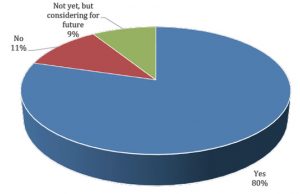
Reasons for Not Having an Adherence Goal
When asked to identify reasons for not using an adherence goal, there were 15 responses. The most common answers included:
- Leadership concerns of potential impact on agent churn
- Union environments limit the options
- Lack of or ineffective measurement tools
- Many other agent metrics already in place
Period of Measurement for Adherence
The respondents were asked over what period the adherence goal is measured. Slightly more than half of the respondents indicated that they measure monthly, with approximately one-third measuring daily. Establishing the period of measurement needs to consider the variations that are likely to occur in the normal course of business. Some periods may have more challenges than others and averaging the good periods with the bad can allow for some reasonable variation. Measuring each day or even week separately can put more emphasis on the occasional challenges than the overall performance. Since fairness is often a concern of the agents, providing some slack for life’s events can help to overcome morale problems.
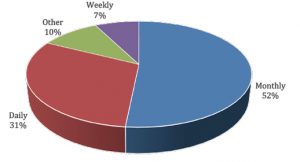
Single Goal vs. Incentives
Respondents were asked whether they had a single goal for schedule adherence or provide incentives for achievement of higher than minimum results. Just over 80 percent of the respondents indicated that they use a single goal. In some cases, setting a minimum with incentives for higher achievement can have negative effects. Agents focused on reaching the higher goals will spend time requesting “forgiveness” for every minute that they can. This can take up their time, their supervisor’s time, and effort in the WFM department entering many schedule exceptions into the tracking system. In the end, the total time accounting for the minor variation can significantly exceed the actual exception.
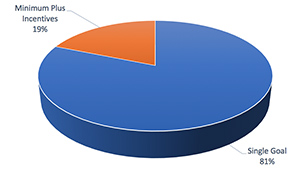
Minimum Adherence Goal Percentage
Respondents were asked to provide the minimum adherence goal used in their centers. The responses vary widely from a few under 80 percent to a few at more than 97 percent. However, more than half of the responses range from 89% to 94%. Determining a reasonable and achievable goal for your center should consider the length of an average handle time, any roadblocks agents may encounter normally (such as distance to break facilities), and other considerations that may inhibit time control (such as dependence on public transportation).
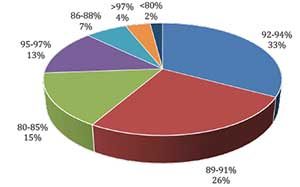
Percentage Goals for Schedule Conformance
Respondents were if they had a goal for schedule conformance in their centers. Conformance is defined as measuring whether the agent worked the total amount of time that the schedule defines but is not concerned with whether the exact time of start, end, or breaks were met. For example, if the agent is 15 minutes late in the morning but works an extra 15 minutes at the end of the shift, the adherence goal will be adversely impacted, but conformance is achieved. Almost 60 percent of the respondents indicated that they do not have a conformance goal. However, 25% do measure it and another 18% are considering this goal for the future. Where an adherence goal is not used due to technical or managerial limitations, conformance may be a reasonable option.
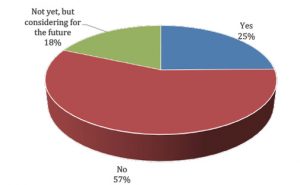
Reasons for Not Using Conformance Goal
Respondents were asked why they do not use a conformance goal in their center. Over 80 answers were provided, and the most common replies include:
- Not a goal the center management wants to use
- Consider adherence goal sufficient
- Technical limitations of measuring
- Union limitations
- Not sure why it is not used
- Measurement Period for Schedule Conformance Goal
When asked what time period the conformance goal is measured over, just over 40 percent indicated that it is a monthly measure, while approximately one-third indicated that it is not measured monthly, daily, or weekly, but some other time period (or perhaps not measured).
Single Goal vs. Incentives for Schedule Conformance
Almost 90 percent of those who measure schedule conformance indicated that it is a single goal with no incentives for more than minimum achievement. The same issues apply in this metric as in schedule adherence mentioned above.
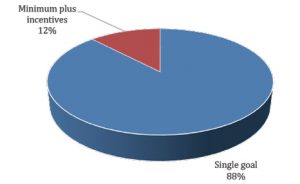
Minimum Conformance Goal
When asked what minimum goal is used to measure schedule conformance, once again the answers vary quite widely from under 80 percent to over 97 percent. But like adherence goals, the majority are clustered between 89 and 97 percent.
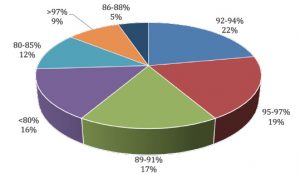
Schedule Exceptions for Long Calls
Respondents were asked if they enter exceptions for agents who are stuck on a long call that continues past a scheduled time such as lunch, break, or end of shift. Almost three-quarters of the respondents indicated that they do not enter such exceptions, with another 17 percent indicating they only enter them if they exceed a minimum length. Only 10 percent enter long call exceptions of any length. This can be a big issue for agents, but ensuring that the goal has taken into account the likelihood of long calls, and that agents understand that the acceptable percentage of loss is meant to cover these incidents, communication can go a long way to helping maintain morale and minimizing the amount of time spent in handling these exception entry tasks.
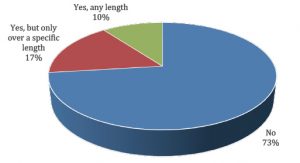
Biggest Challenges
When asked to select those issues that make up the biggest challenges regarding adherence and conformance in their centers, the respondents could choose more than one answer. The two most frequent selections were lack of commitment by managers/supervisors and agents’ perception of fairness. The two choices in the middle were feels like “big brother” and too much data entry. Incentives for higher than minimum achievement were cited by a few and several indicated some other concern not on the list of options.
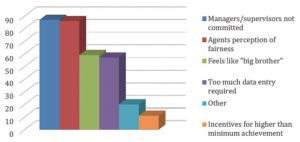
Closing Comments
Based on the responses above, the utilization of goals for schedule adherence are far more commonplace than goals for schedule conformance. The biggest roadblocks for centers not using these goals appear to be management preferences for metrics to use and technical limitations in getting accurate data. For most centers, having the right number of people with the right skills in the right place at the right time is the primary objective. A great deal of effort goes into the development of a reasonably accurate forecast of the workload, followed by a similar effort to create a set of schedules that will balance the needs of the center/customer with those of the agents. If the agents do not follow those schedules, much of the effort is wasted.
